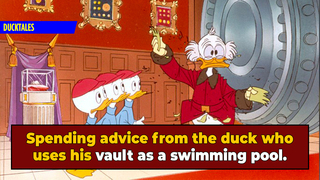Scrooge McDuck's First Cartoon Was Hardcore (Capitalist) Propaganda

Aside from mesmerizing kids with princesses and sinister CGI animal fur, Disney animation has a long history of providing American propaganda. Starting during World War II, Disney heroes like Donald Duck and Mickey Mouse have been used to teach the American public of the dangers of Nazism, loose lips sinking ships, and the patriotic duty of buying war bonds.
But just because the war was over didn't mean the fight for American values had to stop. Rebranded as educational animated shorts, Disney produced a series of 'How To 'Murica' throughout the '50s and '60s. And the most blatantly capitalistic, anti-Soviet of them all has to be the animated debut of Disney's favorite billionaire tycoon: Scrooge McDuck, in the 1967 short Uncle Scrooge and Money.
In Uncle Scrooge and Money, Huey, Dewey, and Louie come visit their adoring great-uncle in the hopes of becoming filthy rich just like him. This was a massive departure for old Scrooge. Previously, the exclusive Disney comic book character was portrayed more as the Gordon Gecko of waterfowl, a greedy miser who'd more likely foreclose on Goofy's house after trapping him in a predatory loan than lift a wing to help out others. But in his first short, Scrooge gets promoted from Scottish comic relief to the American hero of capitalism. Or specifically, consumerism. Because when the Duck triplets reveal they want him to put their dollar ninety-five cents in the bank, Scrooge balks at the notion. Thus follows a lesson in money, where despite Scrooge's comical Scottish brogue and rhyming scheme, he imparts a very serious lecture on the importance of money, the spending of money, and capitalism's greatest enemy, inflation.
Between some very interesting tidbits on the history of currency, like Romans using salt and the exchange rate on bronze knives and goats, Scrooge McDuck uses his Scottish brogue and weird rhyming scheme to charm his underaged audience (both in the short and, more importantly, in the audience) into accepting that making money is the fastest road to happiness. After the opening song titled "Circulate! Circulate!" Scrooge claims that since the Stone Age, people have been wailing and commiserating: "We need money!" Until the modern age arrived when happy capitalists would sing aloud: "Our money's fine, now all that we need is more!" And that earning a billion dollars would build you "a nice bridge to the beaches of Waikiki."

Now, you might wonder why anyone would take advice about spending money to make money from a cartoon character best known for keeping his cash in a vault to swim around in. But the short also addresses that question by revealing that Scrooge's "Bin" is actually just a repository for his "petty cash," and his real wealth is always being circulated in large investments. That this spare change could solve world hunger several times over instead of acting as a kiddie pool for a gazillionaire duck to corkscrew-penis dive into isn't really tackled.
Uncle Scrooge and Money has the dubious honor of likely being one of Walt Disney's last projects, as this was the first animated short released after his death in 1966. What better way to announce to the world that it's Disney business as usual? And while in today's world of real Scrooge McDuck's like Jeff Bezos and Elon Musk, we might not have the same taste for a cartoon that's hyper-capitalist, anti-socialist, and blatantly tries to indoctrinate children to embrace the virtues of Reaganomics, this 16-minute short will still teach you more about the realities of consumerism and investing money than any high school Home Ec. class. So whatever economic structure you prefer, Uncle Scrooge and Money is definitely worth a watch.
For more trickle-down tangents, do follow Cedric on Twitter.
Top Image: Disney